Dynamic Positioning Control of Large Ships in Rough Sea Based on an Improved Closed-Loop Gain Shaping Algorithm
Abstract
:1. Introduction
- (1)
- Introduced the equivalent ship speed model and analyzed the conversion relationship between relative wind and absolute wind, based on which, the ship’s headwind stationary motion model was established. This model effectively showed that large ships remain stationary at sea under the interference of external wind and waves. The model plays an important role in the research of dynamic positioning fixed-point control.
- (2)
- The forward speed controller was designed by using the closed-loop gain shaping algorithm, and the nonlinear course-keeping robust controller was designed by combining the closed-loop gain shaping algorithm and the exact feedback linearization algorithm. To overcome the influence of strong external interference on the stability of the system, and thus to meet the demand for fixed-point control, the author decoupled the ship motion and designed the dynamic positioning system using the forward speed controller with the nonlinear course-keeping robust controller. This effectively solved issues with the large-ship control effect in rough seas not being ideal and the result being easy to disperse, and accomplished large-ship fixed-point control at sea.
2. Establishment of Mathematical Model for Ship Dynamic Positioning System
2.1. Wind Disturbance Force Model in Rough Sea
2.2. Equivalent Ship Speed Model
2.3. Ship Kinematics Model
3. Dynamic Positioning Controller Based on Closed-Loop Gain Shaping Algorithm
3.1. Design of Speed Controller
3.2. Design of the Nonlinear Course-Keeping Robust Controller
4. General System Design
5. Simulation Verification and Results Analysis
6. Conclusions
- (1)
- We built a stationary motion model of ship headwind by introducing an equivalent ship speed model and analyzing the conversion relationship between the relative wind and absolute wind. The model effectively showed the large ship overcoming strong external disturbances and remaining stationary at sea, providing good modeling support for research into large ship fixed-point control in rough sea conditions.
- (2)
- In order to overcome strong external disturbances at a level-9 sea state, the authors decoupled the ship motions and built a mathematical model. Combining the closed-loop gain shaping algorithm with an exact feedback linearization algorithm to design a nonlinear course-keeping robust controller, the designed dynamic positioning control system combined a ship speed controller with a nonlinear course-keeping robust controller. The simulation results proved that the fixed-point control errors of the three ships were all less than 10 m, which meets the fixed-point control requirements of large ships in rough sea conditions.
Author Contributions
Funding
Institutional Review Board Statement
Informed Consent Statement
Data Availability Statement
Conflicts of Interest
References
- Zhang, G.Q.; Yao, M.Q.; Yang, T.T.; Zhang, W.D. Ship adaptive dynamic positioning control considering event-triggered input. J. Control Theory Appl. 2021, 38, 1597–1606. [Google Scholar] [CrossRef]
- Du, J.L.; Hu, X.; Krstić, M.; Sun, Y.Q. Robust dynamic positioning of ships with disturbances under input saturation. Automatica 2016, 73, 207–214. [Google Scholar] [CrossRef]
- Zhang, X.M.; Han, Q.L.; Yu, X. Survey on recent advances in networked control systems. IEEE Trans. Ind. Inform. 2015, 12, 1740–1752. [Google Scholar] [CrossRef]
- Tutturen, S.A.; Skjetne, R. Hybrid control to improve transient response of integral action in dynamic positioning of marine vessels. IFAC Pap. 2015, 48, 166–171. [Google Scholar] [CrossRef]
- Zhou, Q.R.; Zeng, Q.J.; Yao, J.Y.; Zhu, Z.Y.; Dai, W.W. Design and implementation of fully-actuated AUV dynamic positioning system. J. Underw. Unmanned Syst. 2019, 27, 333–338. [Google Scholar] [CrossRef]
- Jayasiri, A.; Ahmed, S.; Imtiaz, S. Wavelet-based controller design for dynamic positioning of vessels. IFAC Pap. 2017, 50, 1133–1138. [Google Scholar] [CrossRef]
- Li, J. Application of nonlinear observer in DP of ship dynamic positioning system. Ship Sci. Technol. 2021, 43, 208–210. [Google Scholar] [CrossRef]
- Tong, J.J.; He, L.M.; Tian, Z.H. Mathematical model of ship dynamic positioning system. Ship Eng. 2002, 05, 27–29. [Google Scholar] [CrossRef]
- Yu, P.W.; Chen, H. Design of optimal controller for dynamic positioning system. Adv. Mater. Res. 2011, 308, 2127–2130. [Google Scholar] [CrossRef]
- Cho, S.; Shim, H.; Kim, Y.S. Dynamical sliding mode control for robust dynamic positioning systems of FPSO vessels. J. Mar. Sci. Eng. 2022, 10, 474. [Google Scholar] [CrossRef]
- Guan, K.P.; Zhang, X.F. Research on sliding mode control ship dynamic positioning control system. Ship Sci. Technol. 2018, 40, 61–65. [Google Scholar] [CrossRef]
- Mu, D.D.; Feng, Y.P.; Wang, G.F.; Fan, Y.S.; Zhao, Y.S.; Sun, X.J. Ship dynamic positioning output feedback control with position constraint considering thruster system dynamics. J. Mar. Sci. Eng. 2023, 11, 94. [Google Scholar] [CrossRef]
- Guo, Q.; Zhang, X.K.; Han, X. Robust adaptive event-triggered path following control for autonomous surface vehicles in shallow waters. Ocean Eng. 2023, 286, 115571. [Google Scholar] [CrossRef]
- Zhang, G.Q.; Yao, M.Q.; Xu, J.H.; Zhang, W.D. Robust neural event-triggered control for dynamic positioning ships with actuator faults. Ocean Eng. 2020, 207, 107292. [Google Scholar] [CrossRef]
- Bidikli, B. An adaptive control design for dynamic positioning of unmanned surface vessels having actuator dynamics. Ocean Eng. 2021, 229, 108948. [Google Scholar] [CrossRef]
- Wei, X.J.; Zhang, H.F.; Wei, Y.L. Composite hierarchical anti-disturbance control for dynamic positioning system of ships based on robust wave filter. Ocean Eng. 2022, 262, 112173. [Google Scholar] [CrossRef]
- Su, Y.X.; Gong, C.L.; Zhang, D.H.; Hu, X. Simple Dynamic Positioning Control Design for Surface Vessels With Input Saturation and External Disturbances. IEEE Trans. Circuits Syst. II Express Briefs 2022, 70, 1530–1534. [Google Scholar] [CrossRef]
- Tomera, M.; Podgórski, K. Control of dynamic positioning system with disturbance observer for autonomous marine surface vessels. Sensors 2021, 21, 6723. [Google Scholar] [CrossRef]
- Zhang, G.Q. Simple Robust Adaptive Control of Ship Motion in Severe Sea Conditions. Ph.D. Thesis, Dalian Maritime University, Dalian, China, 2015. [Google Scholar] [CrossRef]
- Jia, X.L.; Yang, Y.S. Mathematical Model of Ship Motion: Mechanism Modeling and Identification Modeling; Dalian Maritime University: Dalian, China, 1999. [Google Scholar]
- Jia, X.L.; Zhang, X.K. Ship Motion Intelligent Control and H∞ Robust Control; Dalian Maritime University: Dalian, China, 2002. [Google Scholar]
- Song, C.Y.; Zhang, X.K.; Zhang, G.Q. Nonlinear identification for 4-DOF ship maneuvering modeling via full-scale trial data. IEEE Trans. Ind. Electron. 2021, 69, 1829–1835. [Google Scholar] [CrossRef]
- Jiang, Z.R. Modeling and Simulation of Control System: Analysis and Implementation Based on MATLAB/Simulink; Tsinghua University: Beijing, China, 2020. [Google Scholar]
- Menini, L.; Tornambè, A. Exact and approximate feedback linearization without the linear controllability assumption. Automatica 2012, 48, 2221–2228. [Google Scholar] [CrossRef]
- Song, C.Y.; Zhang, X.K.; Zhang, G.Q. Nonlinear innovation-based maneuverability prediction for marine vehicles using an improved forgetting mechanism. J. Mar. Sci. Eng. 2022, 10, 1210. [Google Scholar] [CrossRef]
- Zhou, Z.Y.; Zhang, Y.J.; Wang, S.B. A coordination system between decision making and controlling for autonomous collision avoidance of large intelligent ships. J. Mar. Sci. Eng. 2021, 9, 1202. [Google Scholar] [CrossRef]
- Ren, R.Y.; Zou, Z.J.; Wang, Y.D.; Wang, X.G. Adaptive Nomoto model used in the path following problem of ships. J. Mar. Sci. Technol. 2018, 23, 888–898. [Google Scholar] [CrossRef]

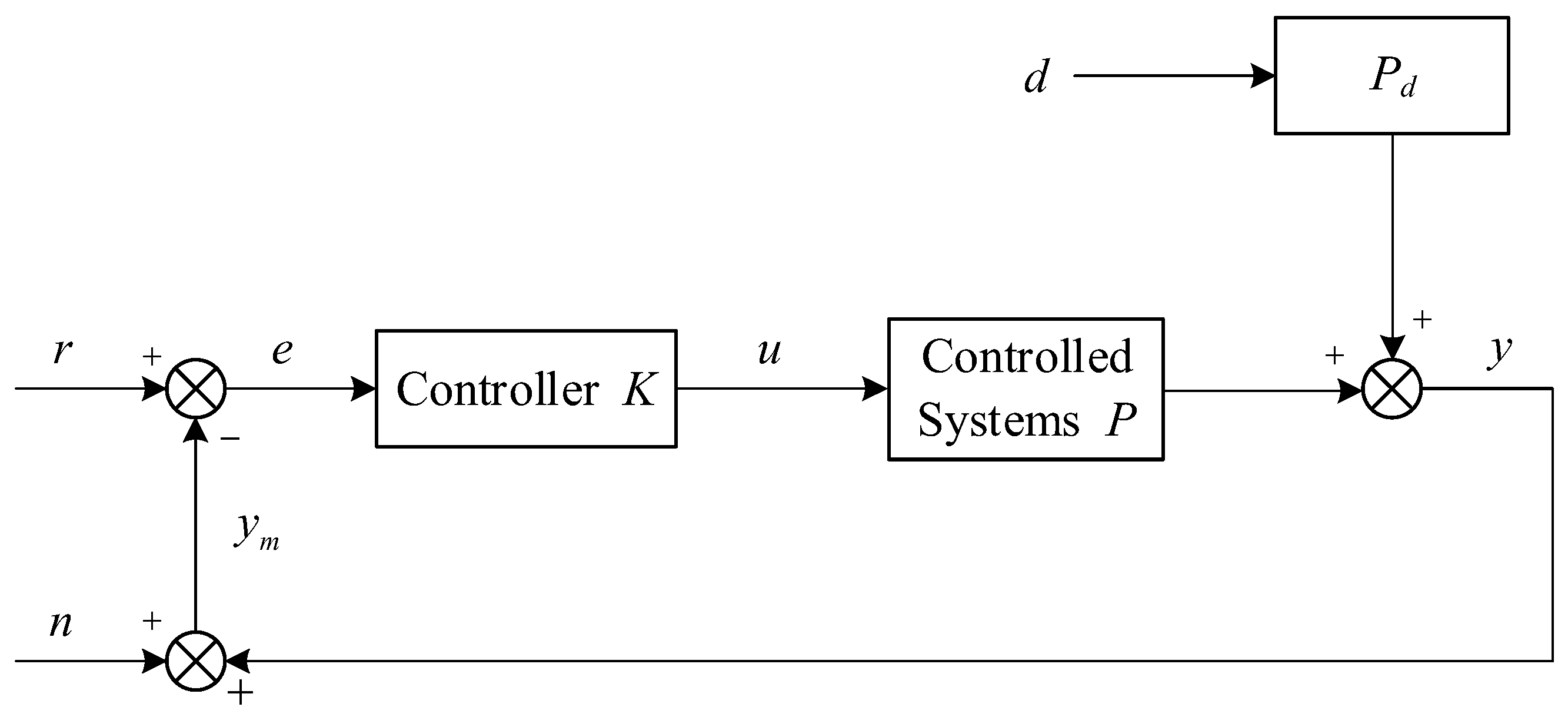
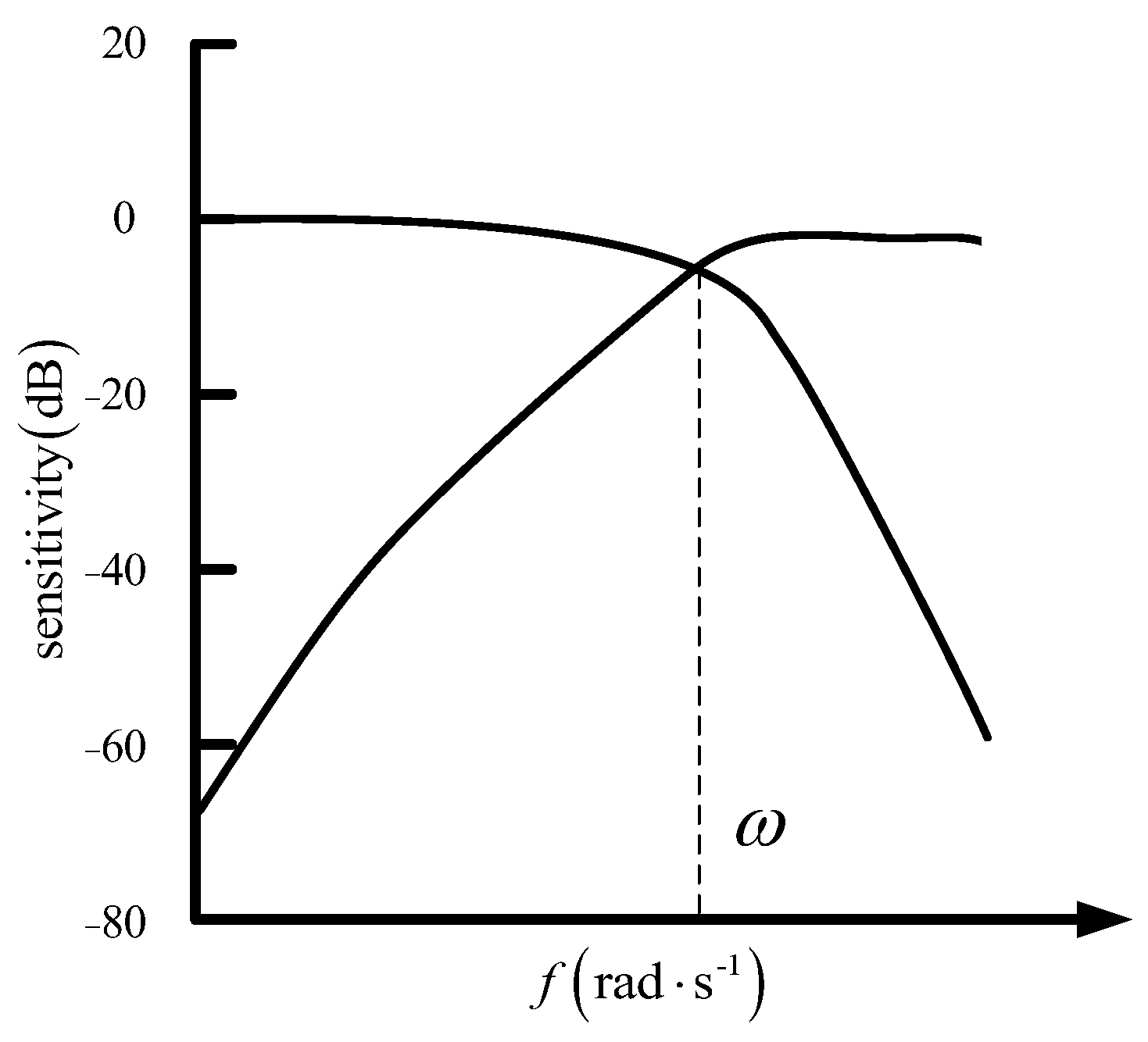

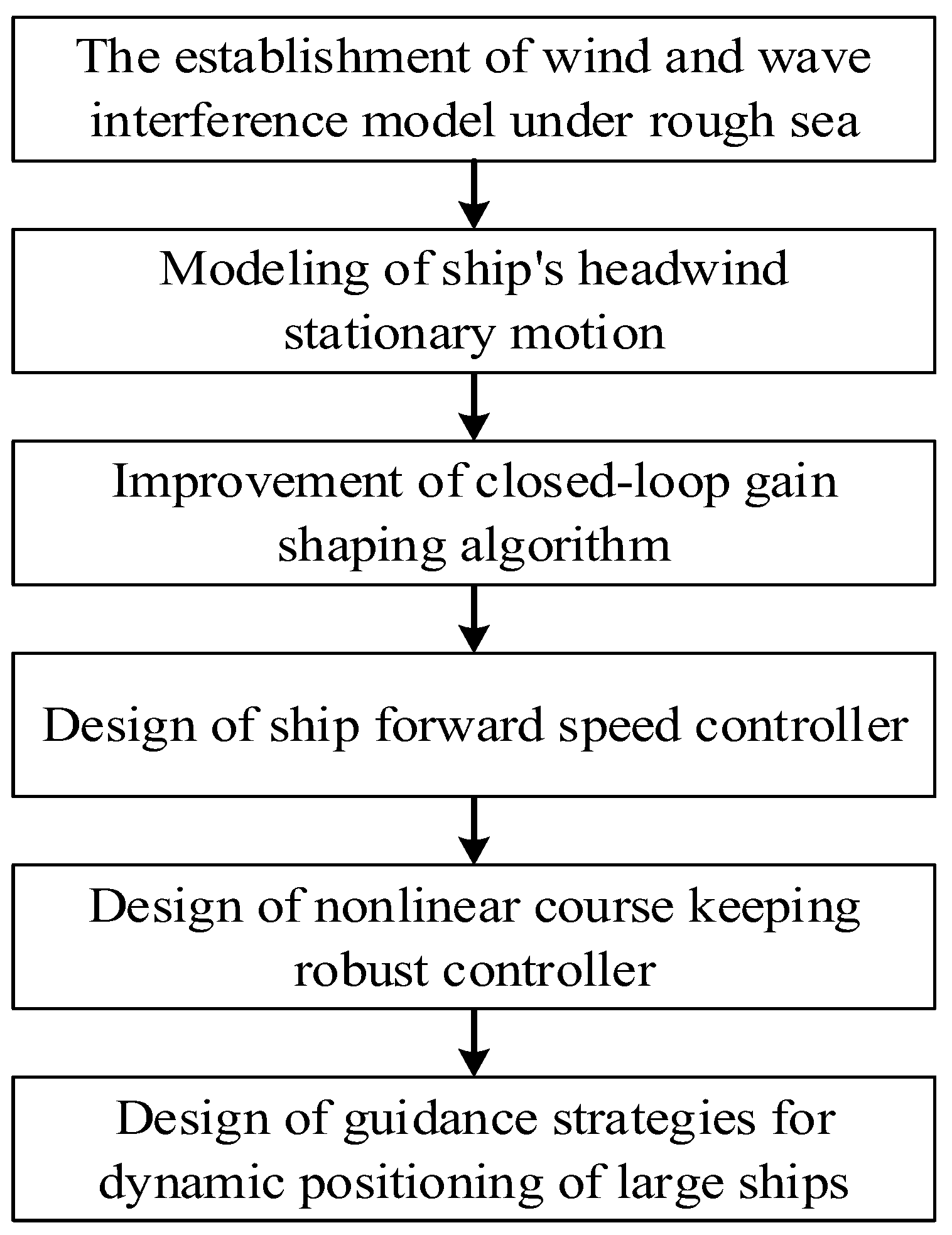

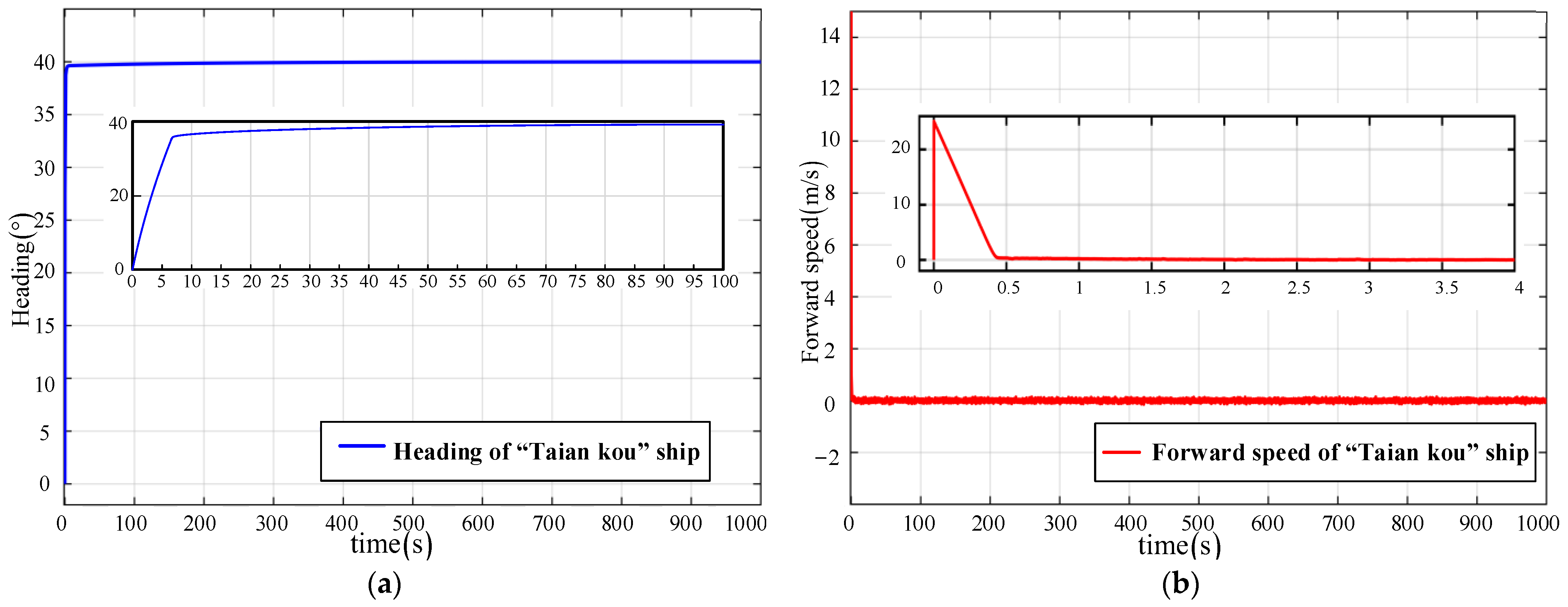

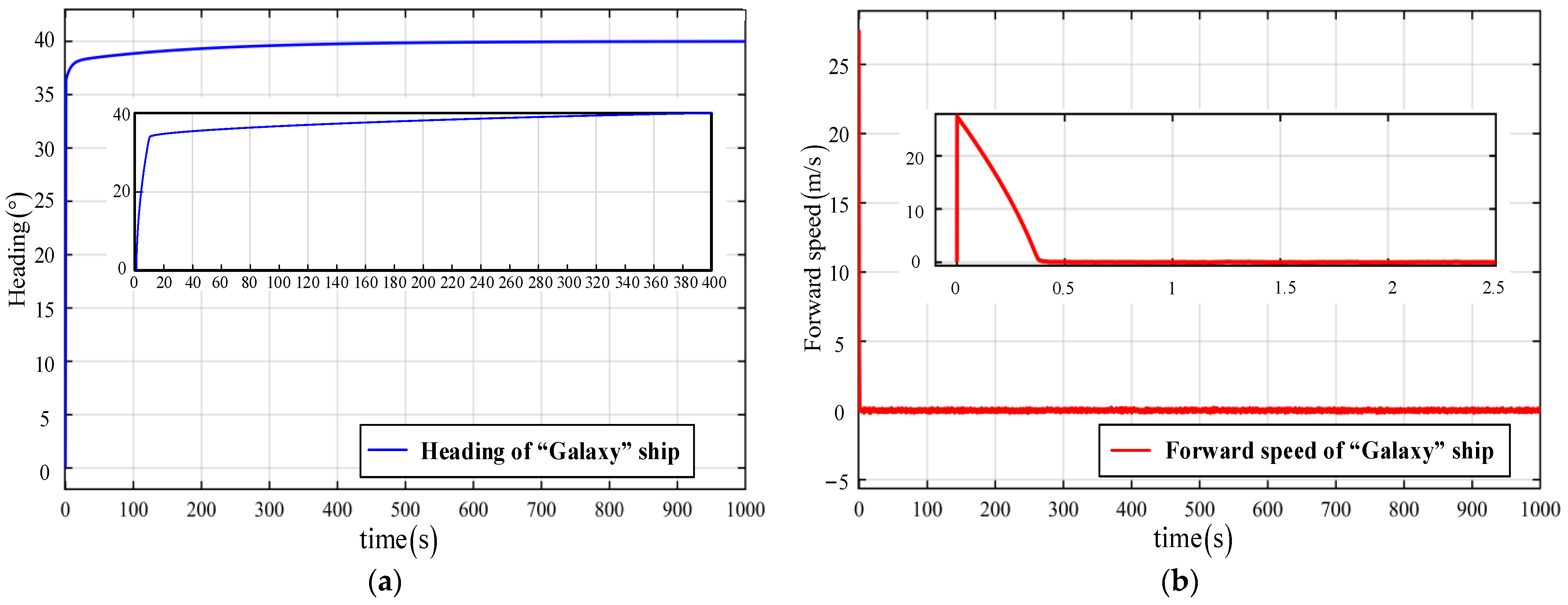

| Quantity | Symbol | Value | ||
|---|---|---|---|---|
| “Taian kou” Ship | “Mariner” Ship | “Galaxy” Ship | ||
| Length between perpendiculars | 145.00 | 160.93 | 160.00 | |
| Breadth | 36.00 | 23.17 | 28.00 | |
| Draft | 7.40 | 8.23 | 9.50 | |
| Displacement | 30,881.2 | 19,004.5 | 28,848.6 | |
| Rudder area | 20.4 | 30.1 | 38.9 | |
| Paddle diameter | 4.0 | 6.7 | 6.3 | |
| Block coefficient | 0.787 | 0.558 | 0.652 | |
| Ship | Maneuverability Index | Nonlinear Parameter | ||
|---|---|---|---|---|
| K | T | α | β | |
| “Taian kou” ship | −0.20 | −212.96 | 8.94 | 33,624.80 |
| “Mariner” ship | 0.10 | 48.85 | 16.75 | 20,887.82 |
| “Galaxy” ship | 0.48 | 186.82 | 8.87 | 8911.21 |
| Ship | Heading | Forward Speed | ||
|---|---|---|---|---|
| Reference Value | Actual Value | Reference Value | Actual Value | |
| “Taian kou” ship | 40° | 40° | 0 | 0 0.3 |
| “Mariner” ship | 40° | 40° | 0 | 0 0.65 |
| “Galaxy” ship | 40° | 40° | 0 | 0 0.8 |
Disclaimer/Publisher’s Note: The statements, opinions and data contained in all publications are solely those of the individual author(s) and contributor(s) and not of MDPI and/or the editor(s). MDPI and/or the editor(s) disclaim responsibility for any injury to people or property resulting from any ideas, methods, instructions or products referred to in the content. |
© 2024 by the authors. Licensee MDPI, Basel, Switzerland. This article is an open access article distributed under the terms and conditions of the Creative Commons Attribution (CC BY) license (https://creativecommons.org/licenses/by/4.0/).
Share and Cite
Song, C.; Guo, T.; Sui, J.; Zhang, X. Dynamic Positioning Control of Large Ships in Rough Sea Based on an Improved Closed-Loop Gain Shaping Algorithm. J. Mar. Sci. Eng. 2024, 12, 351. https://doi.org/10.3390/jmse12020351
Song C, Guo T, Sui J, Zhang X. Dynamic Positioning Control of Large Ships in Rough Sea Based on an Improved Closed-Loop Gain Shaping Algorithm. Journal of Marine Science and Engineering. 2024; 12(2):351. https://doi.org/10.3390/jmse12020351
Chicago/Turabian StyleSong, Chunyu, Teer Guo, Jianghua Sui, and Xianku Zhang. 2024. "Dynamic Positioning Control of Large Ships in Rough Sea Based on an Improved Closed-Loop Gain Shaping Algorithm" Journal of Marine Science and Engineering 12, no. 2: 351. https://doi.org/10.3390/jmse12020351






